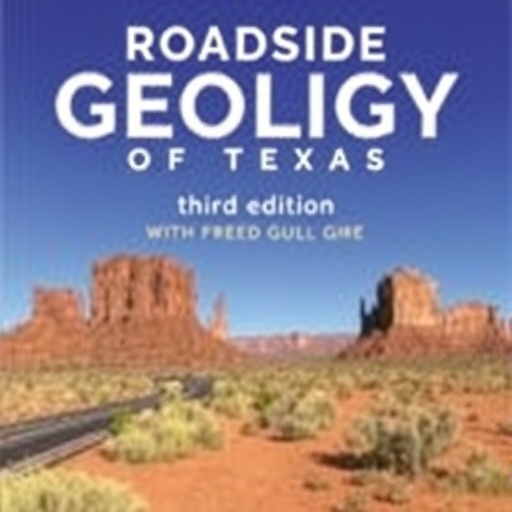The Geological Society of America (GSA) proudly announces the forthcoming release of the third edition of the acclaimed “Roadside Geology of Texas,” a comprehensive guide designed to illuminate the extraordinary geological heritage of one of the most geologically diverse states in the United States. This updated edition, the first major revision since 1991, promises to be an indispensable resource for geologists, enthusiasts, and travelers alike who seek to understand the dynamic processes that have sculpted Texas’s varied landscapes over more than a billion years.
Texas stands as a geological marvel, exhibiting a remarkable spectrum of rock types and formations that chronicle the Earth’s deep history. The “Roadside Geology of Texas, Third Edition” offers readers a unique vantage point from the comfort of their vehicle, providing accessible yet scientifically rigorous explanations of the geologic phenomena visible along fifty carefully selected routes across the state. This includes highways threading through some of the most iconic natural features, such as the jagged peaks of the Guadalupe Mountains, the limestone-clad Edwards Plateau, and the ever-shifting dune systems along the Gulf Coast.
This new edition not only revives its predecessor’s content but enhances it with over 250 vibrant color photographs and detailed illustrations, offering an unparalleled visual experience of Texas’s geologic character. The inclusion of updated geologic maps lends precision to the field experience, allowing users to locate themselves within the geologic timeline and spatial context. Such cartographic resources are pivotal for understanding regional stratigraphy, structural geology, and the distribution of mineral resources, including hydrocarbon reservoirs beneath the surface.
The geologic narrative embodied in this volume spans from Precambrian crystalline basement rocks, dating back over a billion years, to the sedimentary sequences that trace the rise and fall of ancient seas, the relentless sculpting by wind and water, and the tectonic forces that continue to shape the region. Texas’s subsurface geology holds immense economic significance, particularly concerning petroleum geology, as many of these sedimentary basins harbor rich deposits of oil and natural gas. This guide aids not only tourists and scholars but also professionals who seek to grasp the complexity of these formations.
Particularly noteworthy is the coverage of Big Bend National Park, where five highlighted routes reveal an extraordinary array of geological features that illustrate mountain-building processes, volcanic activity, and erosional landscapes. The park serves as an open-air laboratory where one can observe fault lines, fault-block mountains, and sedimentary layering that combine to tell a dynamic story of Earth’s evolving crust.
In addition to the routes and maps, the third edition enriches the reader’s comprehension with a glossary of geological terms, detailed indexes, and suggested readings that support deeper exploration into specific topics. The integration of these elements broadens the scope and usability of the guide, making it suitable for both academic study and casual exploration.
Authored by Paul Brandes and Darwin Spearing, both of whom bring extensive expertise in geoscience, the book benefits from years of field research, photography, and scholarship. Brandes, notable for his previous works “New Mexico Rocks!” and “Michigan Rocks!”, contributes a photographer’s eye that captures the often-overlooked beauty of geological features. Illustrator Chelsea M. Feeney’s contributions further enhance the visual clarity of complex geologic concepts, making the material engaging and comprehensible.
The Geological Society of America, with its 17,000+ members worldwide, continues to foster scientific knowledge and public awareness of Earth sciences through such publications. As a respected authority, GSA’s backed resources ensure that the information conveyed is accurate, current, and reflective of the latest scientific understandings in geoscience research.
Texas’s geological identity encapsulates the interfacing of numerous geodynamic settings, from ancient mountain-building episodes to gulf coast sedimentation, providing a template for understanding broader Earth processes. This edition of “Roadside Geology of Texas” serves not just as a travel companion but as a gateway to appreciating the profound temporal and spatial scales at which geologic forces operate.
The book is set for release on November 4, 2025, and will be available as a trade paperback featuring 374 pages of rigorous scholarship combined with stunning visual aids. Priced at $34, it represents exceptional value for students, educators, professionals, and armchair geologists preparing to embark on a scientific journey across Texas.
Journalists and media professionals interested in securing a copy for review and coverage are encouraged to contact Kalen Landow at klandow@geosociety.org to request a finished edition. Those who venture through Texas armed with this guide will gain not only a deeper appreciation of the state’s natural history but also an understanding of the dynamic forces that continue to shape the physical environment today.
From the subtle weathering patterns on limestone cliffs to the dramatic tectonic upheavals recorded in fault lines, every page invites readers to witness the story written in stone. By connecting the dots between field observations and underlying scientific principles, the “Roadside Geology of Texas, Third Edition” fosters a richer connection to the planet’s dynamic history — an experience that transcends traditional travel, turning every roadside stop into a classroom without walls.
Subject of Research: Geology of Texas and its geological features along key travel routes.
Article Title: Geological Society of America Announces New Release of “Roadside Geology of Texas, Third Edition”
News Publication Date: Not specified (Pre-publication announcement; book release date November 4, 2025)
Web References: https://www.geosociety.org/
Image Credits: The Geological Society of America
Keywords: Geology, Earth sciences, Physical sciences, Texas geology, Roadside Geology, Guadalupe Mountains, Edwards Plateau, Big Bend National Park




